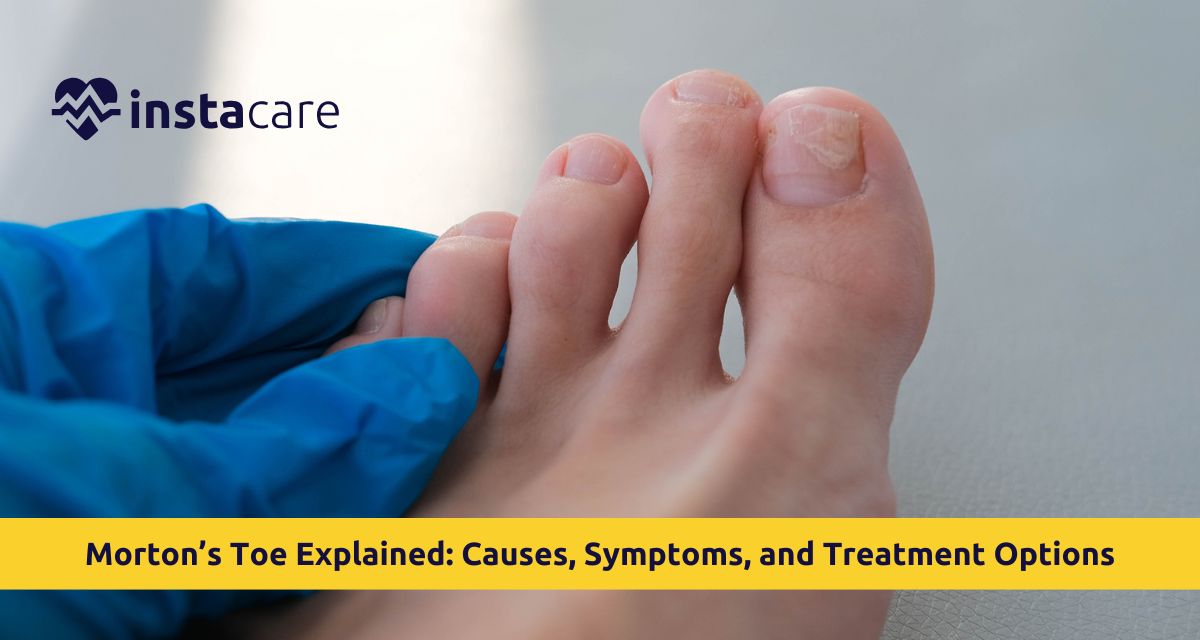What Is Morton’s Toe?
Morton Toe is named after an American orthopedic surgeon Dr. Dudley Joy Morton, who was the first to describe it in the early 20th century. It is a shortening of the first metatarsal bone thus causing the second toe to look longer. This distortion in the bones alters the distribution of pressure during walking and may cause pain or a lack of alignment.
This difference in perspective of the foot anatomy and Morton’s toe may be seemingly minuscule, but in terms of arches of the feet and overall stability of the body, this factor can create a significant influence. In the long run, the wrong distribution of weight can lead to calluses, metatarsalgia (pain in the ball of the foot), and even problems with the higher part of the kinetic chain, such as pain in hips or lower back.
Causes of Morton’s Toe
Hereditary bone structure is the most widespread genetic cause of Morton’s toe. It is usually inherent and inherited. Nevertheless, it may be affected by other factors to develop or become more severe:
- Shoes: Tight or pointed shoes may increase the pressure on the second toe.
- Poor gait mechanisms: Overpronation or unbalanced walking can worsen the symptoms.
- Physical stress: Sports, running, or standing on the foot most of the time strain the forefoot.
- Weak arches: Fallen arches or flat feet will exacerbate the pain associated with Morton Toe.
Signs and Symptoms of Morton Toe
The first step to solving the problem is to recognize Morton's toe symptoms. Common signs include:
- Suffering under the second toe or the foot ball.
- Development of corns, calluses or hardened skin under toes.
- Long-term walking or standing causes fatigue on feet.
- Numbness or tingling in the nerves occasionally as a result of compression.
- Alterations in balance or walking.
How Morton’s Toe Affects the Body?
The Toe of Morton does not just mean your feet. Since your feet are the base of your posture, any minor imbalance would have an impact on your whole body. As you walk, every strain is put on your feet with each step. In Toe, by Morton, the second toe carries more weight than normal. This unequal pressure may result in Morton’s toe and posture resulting in alteration of walking rhythm and posture.
Such imbalances can eventually cause Morton’s toe and back pain, knee tension or even hip dislocation. This cause and effect demonstrates the importance of having the right foot structure to ensure the entire body is healthy and stable.
Diagnosis of Morton Toe
To have a correct Morton’s toe diagnosis, a simple physical examination is usually sufficient. A podiatrist will determine the length of toes, the height of arch, and the general form of the foot. In other instances, X-rays or gait tests can be ordered to know the bone position and pressure areas in detail.
The important diagnostic procedures are:
- Toe length visual inspection.
- Foot pressure mapping
- Assessment of stance and gait.
- X-ray photography to determine bone percentages.
Treatment and Management of Morton Toe
Morton Toe treatment can be done depending on the intensity of discomfort. This aims at relieving pain, repositioning, and returning to normal walking patterns.
Some of the most common treatment of the toe of Morton are:
- Orthotic aids: Morton’s toe orthotics is made in order to help distribute pressure to the whole foot evenly and alleviate pain.
- Shoe modifications: Choose a pair of shoes that have a spacious toe area, excellent foot support, and soft soles.
- Minimal pain management: If over-the-counter anti-inflammatories are used, they may be effective, or Morton’s toe pain relief pads.
- Physical therapy: The calf and foot muscles should be strengthened to enhance stabilization and balance.
- Surgical repair: Surgery can be resorted to in rare instances to correct the length of the metatarsal bone.
Home Remedies and Foot Care Tips
Though treatment is necessary, home remedies are also important to relieve pain in addition to professional treatment.
These are the simple and effective methods that can be tried:
- Warm the feet with Epsol salts in warm water.
- Do Morton’s toe exercises like towel curls and toe stretches that Perform gentle Morton suggested.
- Rub in arches and soles to enhance blood flow.
- Use ice to lessen the swelling at the end of a day of walking.
- Wear protective sandals or orthotic slippers at home.
Read More: Hammer Toe: Causes, Symptoms, Treatment, and Prevention
Living Comfortably with Morton’s Toe
You can comfortably live and remain active with Morton Toe. Awareness and care are key. Good posture, correct choice of shoes, and supportive insoles would help a good deal in minimizing daytime discomfort. When you ask yourself how to fix Morton’s toe without surgery, you would need to emphasize on strengthening the muscles of the foot, enhancing mobility and padding it to give it some extra comfort. Consider adding some stretching exercises to your routine to ensure that your feet are supple and correct.
Myths and Misconceptions about Morton's Toe
People can be deceived with a lot of myths around the Morton Toe. Another myth that is widely accepted is the long second toe meaning, the intelligence or creativity. Although it makes fun folklore, the size of toes has no scientific evidence of having any connection to personality. Finally, it is mistaken for bunions. But Morton’s toe vs bunion where Morton has a toe that is related to the bones below the second toe and the bunion is related to the big toe joint.
When to See a Doctor for Morton Toe
Despite the fact that most people can Morton’s toe treatment at home, a doctor is required in case the pains are complex and chronic. Consult a doctor in case you have:
- Permanent pain or swelling.
- Problems with walking balance.
- Self-care worsening calluses.
- Nerve irritation or numbness.
Conclusion
Morton Toe is not just a structural anomaly, it is a disease that may affect the comfort, mobility and pose. Modern Morton has provided Morton’s toe treatment, orthotics and simple home care and with these alternatives living painless is a definite possibility.
Please book an appointment with the
Best Orthopedic Surgeon in Lahore, Karachi, Islamabad, and all major cities of Pakistan through
InstaCare, or call our helpline at 03171777509 to find a verified doctor for your disease.

